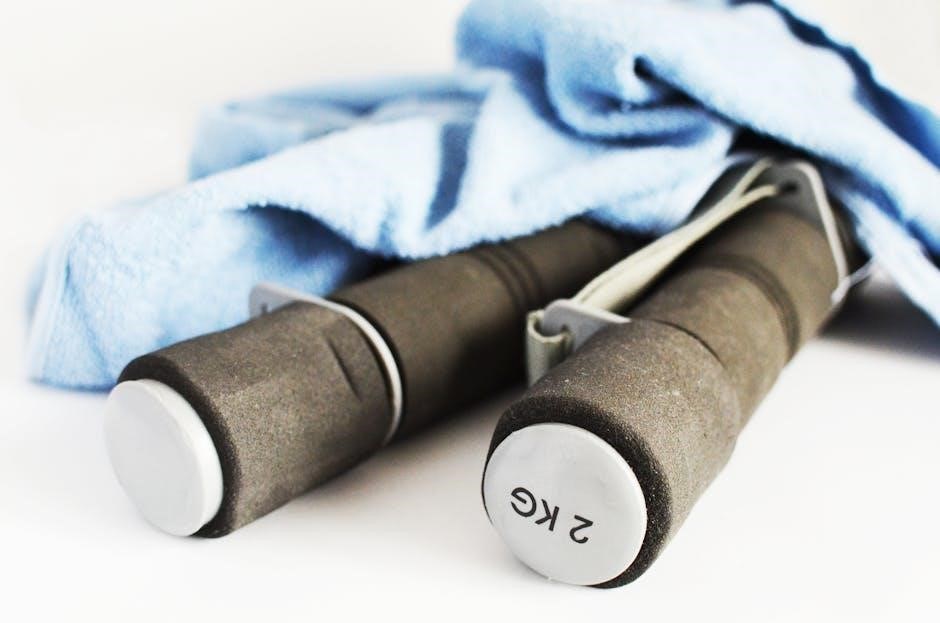metabolic resistance training workouts pdf

Metabolic Resistance Training (MRT) combines strength training with high-intensity intervals to maximize calorie burn and boost metabolism. It involves compound movements with minimal rest, enhancing efficiency and results.
What is MRT?
Metabolic Resistance Training (MRT) is a hybrid workout style combining strength training with high-intensity intervals. It involves performing compound movements like squats or kettlebell swings with minimal rest to maximize calorie burn and metabolic boost; This approach blends cardio and resistance exercises, making it a time-efficient way to enhance fat loss, muscle growth, and overall fitness. MRT is designed for those seeking a challenging, effective, and efficient training method.
Why Choose MRT for Fat Loss and Muscle Building?
MRT is ideal for fat loss and muscle building due to its unique combination of strength training and high-intensity intervals. It burns calories both during and after workouts while promoting muscle growth. By targeting multiple muscle groups with compound movements, MRT enhances metabolism and boosts efficiency. This method is perfect for those seeking a time-effective way to achieve leaner, stronger physiques without sacrificing results.

Benefits of Metabolic Resistance Training
Metabolic Resistance Training boosts metabolism, burns calories, builds muscle, and is time-efficient, making it ideal for fat loss and strength gains.
Calorie Burn and Metabolism Boost
Metabolic Resistance Training is highly effective for burning calories both during and after workouts. It creates an afterburn effect, known as EPOC, boosting metabolism for hours. This results in increased calorie burn even at rest. By combining strength training with high-intensity intervals, MRT maximizes energy expenditure, making it ideal for fat loss and improving metabolic health. Its efficiency allows for significant calorie burn in shorter workout sessions.
Muscle Growth and Strength Improvement
MRT stimulates muscle growth by engaging multiple muscle groups simultaneously. The combination of resistance exercises and high intensity triggers the release of growth hormones and testosterone. This promotes hypertrophy and strength gains. By focusing on compound movements like squats and deadlifts, MRT effectively builds lean muscle mass while improving overall strength. The minimal rest periods also enhance muscle fiber recruitment, leading to faster progress in strength and muscle development.
Time Efficiency
MRT workouts are designed to be time-efficient, delivering maximum results in minimal time. By combining strength training with high-intensity intervals, MRT sessions often last 20-30 minutes. The structure of circuits with short rest periods ensures a full-body workout without prolonged downtime. This makes MRT ideal for individuals with busy schedules seeking to improve fitness, burn fat, and build muscle effectively within a short timeframe.

Key Characteristics of MRT Workouts
MRT workouts emphasize compound movements, high-intensity intervals, and minimal rest periods, creating a time-efficient, calorie-burning, and muscle-building experience that maximizes metabolic disturbance and boosts overall fitness.
Compound Movements
Compound movements, such as squats, deadlifts, and kettlebell swings, are central to MRT. These exercises engage multiple muscle groups simultaneously, enhancing efficiency and metabolic stress. By targeting several areas at once, they maximize muscle fiber recruitment, promoting muscle growth and calorie burn. This approach ensures a full-body workout, making MRT highly effective for both fat loss and strength gains in a short time frame.
High-Intensity Intervals
High-intensity intervals in MRT involve short bursts of maximum effort followed by brief rest periods. This structure accelerates heart rate and pushes the body to its limits, enhancing calorie burn and metabolic afterburn. By maintaining minimal rest, the workouts stay challenging, ensuring sustained engagement of both cardiovascular and muscular systems for optimal fat loss and muscle endurance. This method is key to MRT’s effectiveness in achieving rapid results.
Minimal Rest Periods
Minimal rest periods in MRT are designed to keep the heart rate elevated, maximizing the workout’s efficiency. By reducing downtime between exercises, the body remains in an active state, enhancing calorie burn and metabolic stress. This approach not only saves time but also intensifies the challenge, promoting faster progress toward fitness goals. Short rest intervals are a cornerstone of MRT, ensuring a rigorous and effective training experience that yields noticeable results.
Best Exercises for MRT
The best MRT exercises include Kettlebell Swings, Burpees, Mountain Climbers, Dumbbell Step-Ups, and Goblet Squats. These compound movements target multiple muscle groups for efficient fat loss and muscle building.
Kettlebell Swings
Kettlebell Swings are a powerful MRT exercise that combines strength and cardio. They engage the hips, legs, and core, promoting full-body engagement. Swings are excellent for torching calories and boosting metabolism due to their dynamic, high-intensity movement. Regular practice enhances power, coordination, and overall muscle endurance. Incorporating kettlebell swings into your MRT routine accelerates fat loss and improves functional strength, making them a cornerstone of metabolic resistance training workouts.
Burpees
Burpees are a cornerstone of MRT workouts, combining a squat, push-up, and jump for a full-body challenge. This exercise engages multiple muscle groups, maximizing calorie burn and metabolic impact. Burpees are highly effective for improving endurance, strength, and coordination. Their intensity creates a significant metabolic disturbance, enhancing post-workout calorie burn. Incorporating burpees into your MRT routine boosts fat loss and overall fitness, making them a key component of metabolic resistance training programs.
Dumbbell Step-Ups
Dumbbell Step-Ups are a powerful exercise in MRT workouts, targeting the legs, glutes, and core. Using a step or bench with dumbbells, this movement combines strength and cardio benefits. It improves functional strength, balance, and coordination while elevating heart rate. Step-Ups are versatile, allowing progression by increasing step height or dumbbell weight. They enhance muscle endurance and contribute to a metabolically demanding workout, making them a key component of metabolic resistance training routines for fat loss and muscle building.
Mountain Climbers
Mountain Climbers are a high-intensity, full-body exercise that combines core strength with cardiovascular benefits. This dynamic movement targets the shoulders, arms, and legs while engaging the core. By performing quick, alternating knee drives, climbers elevate heart rate and burn calories rapidly. They are a cornerstone in metabolic resistance training, enhancing endurance, agility, and metabolic rate. Mountain Climbers are ideal for time-efficient workouts, promoting both fat loss and muscle engagement effectively.
Goblet Squats
Goblet Squats are a fundamental exercise in metabolic resistance training, targeting the legs, core, and upper body. Holding a kettlebell or dumbbell close to the chest, this movement engages the quadriceps, hamstrings, and glutes while stabilizing the core. Goblet Squats improve strength, mobility, and metabolic rate. They are a key component of MRT circuits, promoting full-body engagement and maximizing calorie burn during and after the workout, making them highly effective for fat loss and muscle building.

Sample MRT Workout Routines
Full-body circuits like goblet squats, push-ups, and kettlebell swings, repeated for 3 rounds with minimal rest, create effective MRT workouts that torch calories and build muscle efficiently.
Full-Body Circuit Workout
A full-body MRT circuit combines exercises like goblet squats, push-ups, and kettlebell swings, targeting all major muscle groups. Perform each exercise for 12-15 reps, resting 30 seconds between exercises and 1 minute between rounds. This routine boosts metabolism, burns calories, and enhances strength, making it ideal for those seeking efficiency and overall fitness in a short time frame.
Upper Body Focus
An upper body-focused MRT workout targets chest, shoulders, and triceps with exercises like push-ups, dips, and upright rows. Perform 3 sets of 12 reps for each exercise, resting 60 seconds between sets. This routine enhances strength, endurance, and metabolism, while minimizing rest for maximum efficiency.
Lower Body Focus
A lower body-focused MRT workout emphasizes compound movements like goblet squats, Bulgarian split squats, and step-ups. Perform 3 sets of 12-15 reps for each exercise, resting 60 seconds between sets. This routine targets the legs, glutes, and core, promoting muscle engagement, metabolism boost, and overall lower body strength. It’s designed for efficiency, combining resistance training with minimal rest to maximize calorie burn and improve cardiovascular fitness.
Progression and Scaling in MRT
Progress in MRT by increasing weight, reducing rest periods, or modifying repetitions to challenge muscles progressively, enhancing strength and metabolic efficiency over time.
Increasing Weight is a cornerstone of progression in MRT. Gradually adding weight to exercises like goblet squats or kettlebell swings challenges muscles, promoting strength gains. This approach ensures continuous muscle engagement and prevents plateaus. By progressively overloading, individuals build lean muscle and enhance metabolic capacity. Proper form must be maintained to avoid injury, even as weights increase.
Reducing Rest Time
Reducing rest time between exercises and rounds is a key progression strategy in MRT. Shorter rest periods increase the metabolic challenge, enhancing calorie burn and cardiovascular fitness. As fitness levels improve, decreasing rest from 60 to 30 seconds boosts intensity and efficiency, keeping workouts dynamic and effective for fat loss and muscle endurance.
Modifying Repetitions
Adjusting the number of repetitions is a flexible way to tailor MRT workouts to fitness levels and goals. Increasing reps enhances endurance, while lowering them focuses on strength. For example, goblet squats can range from 10-15 reps for hypertrophy or 6-8 reps for power. This approach ensures progressive overload and keeps workouts challenging, preventing plateaus and promoting continuous progress in muscle growth and metabolic efficiency.

Safety and Form in MRT
Proper form is crucial in MRT to prevent injuries and maximize results. Focus on full range of motion and controlled movements to ensure safety and effectiveness.
Proper Form Techniques
Maintaining proper form is essential for both safety and effectiveness in MRT. Engage your core, keep movements controlled, and ensure full range of motion to target muscles effectively. Poor form can lead to injuries and reduce workout efficiency. Focus on slow, deliberate movements, especially during compound exercises like squats or deadlifts, to maximize results and prevent strain on joints and muscles. Consistency in form enhances overall performance and metabolic benefits.
Common Mistakes to Avoid
Common mistakes in MRT include sacrificing form for speed, which can lead to injuries. Overloading with excessive weight too quickly is another pitfall, as it compromises technique. Additionally, neglecting proper warm-ups and cool-downs can increase injury risk and reduce performance. Ignoring rest periods or pushing too hard without recovery can hinder progress. Prioritizing volume over quality and inconsistency in training are also mistakes that can derail MRT effectiveness and goals. Avoid these to ensure safe and successful workouts.
Metabolic Resistance Training (MRT) is a highly effective method for fat loss and muscle growth, offering time-efficient workouts that combine strength and cardio for lasting results.
Final Thoughts on MRT Effectiveness
Metabolic Resistance Training (MRT) stands out as a powerful approach for simultaneous fat loss and muscle building. By merging strength exercises with high-intensity intervals, MRT not only accelerates calorie burn during workouts but also enhances metabolism for sustained energy expenditure. Its time-efficient nature makes it ideal for individuals seeking balanced fitness. Consistent practice leads to improved cardiovascular health, increased lean muscle mass, and a faster resting metabolic rate, ensuring long-term weight management and overall physical well-being.
Leave a Reply
You must be logged in to post a comment.